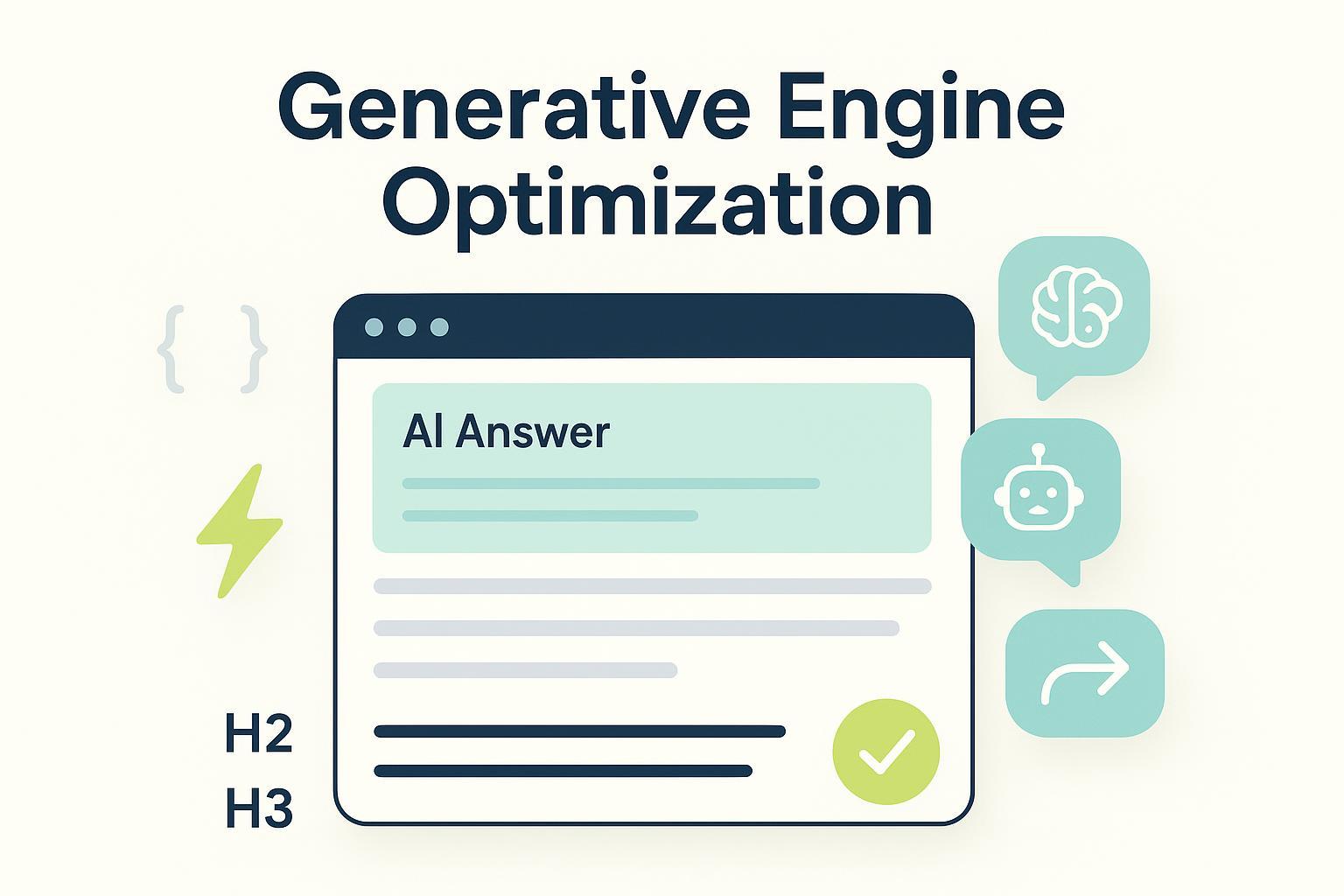Prompt Engineering for Better Brand Mentions in ChatGPT
Master prompt engineering to enhance brand mentions in ChatGPT. Learn techniques for clear prompts, tone alignment, and boosting audience engagement.


Imagine using a tool that helps you make content fit your brand. That’s the cool part of prompt engineering with ChatGPT. It’s not just about asking things; it’s about giving clear steps so AI gives answers your audience will like. Research shows clear prompts make answers better, cut down extra questions, and make users happier. ChatGPT is powerful because it can adjust to your needs, but only if you guide it well. Prompt engineering helps you do that, making it a must-have skill for marketers like you.
Key Takeaways
Write clear and simple prompts for ChatGPT. This helps get better answers that fit your brand's goals.
Add context to your prompts. Sharing details about your audience and goals helps ChatGPT create content that fits well.
Use your brand's tone and style in prompts. This makes the content feel real and easy for your audience to connect with.
Test and tweak your prompts often. Small changes can make the AI's content much better and more engaging.
Try using tools like RACE or TAG to plan your prompts. These tools make your instructions clear and keep your brand message steady.
The Power of ChatGPT in Branding

Using AI for better brand mentions.
AI tools like ChatGPT can help your brand stand out. They create messages your audience likes and remembers. Imagine a campaign boosting brand mentions by 42% or social reach by 38%. That’s the kind of result AI can bring. ChatGPT makes different versions of content to test ideas. This helps you find the best message for your audience. From catchy taglines to helpful replies, AI makes sure your brand gets noticed.
How ChatGPT improves audience connection.
To connect with people, your content must speak to them. ChatGPT helps by studying data and giving useful ideas. It can spot trends or suggest topics your audience cares about. A coffee shop used AI to improve its local listings. This brought more visitors and questions from customers. ChatGPT also creates clean, error-free content, making your brand look professional.
Here’s how ChatGPT boosts engagement:
Metric | Value | Why It Matters |
|---|---|---|
Knowing ChatGPT | Linked to better interactions (ρ=0.181; P=.04) | Leads to longer, meaningful talks with your audience. |
Change in views on quitting smoking | Linked to tailored messaging (ρ=0.296; P<.001) | Shows how custom messages can change opinions effectively. |
Keeping AI outputs aligned with your brand.
Your brand has a special voice, and content should match it. ChatGPT helps by making sure its answers fit your goals. For example, a marketing agency used AI to write case studies faster. This cut work time by 50-60% and boosted website visits by 20-30%. When content matches your goals, it saves time and gets results. Whether it’s a blog, post, or email, ChatGPT keeps your brand’s message clear and strong.
Foundational Principles of Prompt Engineering
Clarity: Writing clear and simple instructions.
Clear instructions are very important in prompt engineering. If your directions are unclear, ChatGPT might give wrong answers. Think of it like giving a friend directions. Would you say, "Go somewhere over there," or "Turn left at the coffee shop, then walk two blocks to the park"? The second one is clear and easy to follow. The same idea works here.
Simple and clear prompts help ChatGPT give better answers. For example, instead of saying, "Can you write about marketing?" try, "Write a 200-word blog post on how small businesses can use social media to connect with customers." This way, the AI knows exactly what you want.
Studies show that clear instructions improve communication and results. Adding specific details, like word count or tone, makes prompts even better. So, before you send a prompt, ask yourself: Is this as clear as possible?
Context: Adding details for better answers.
Context is what makes your prompts work well. Without it, ChatGPT might give general answers that don’t fit your needs. For example, asking, "What’s a good marketing strategy?" is too broad. Instead, ask, "What’s a good marketing strategy for a small bakery to attract local customers?" This gives the AI more information to create a helpful response.
Context is especially useful for brand content. For example, if you’re making a social media post for Geneo, include details like, "Geneo helps businesses improve websites for AI-powered searches. Highlight its AI tools and free 14-day trial." This helps the AI understand your brand and give better answers.
Different industries show why context matters. In healthcare, asking, "Create a treatment plan for a 45-year-old male with diabetes," gives more accurate results. In education, asking for a "high school curriculum on sustainable development" ensures the AI includes useful ideas. The more details you give, the better the response.
Tone and Style: Matching your brand’s voice.
Your brand has its own style, and your content should match it. Whether your tone is formal, casual, or fun, ChatGPT can adjust if you guide it. For example, a formal tone might be, "Please analyze Geneo’s features for enterprise clients." A casual tone could be, "Hey, can you explain why Geneo is great for businesses?"
Matching tone and style with your brand builds trust with your audience. Research shows 65% of people value a good company experience over fancy ads. This means your tone can change how people see your brand. Companies like Mint do this well by keeping their messages simple and friendly, making hard topics like money easy to understand.
To get the tone right, give clear instructions in your prompts. For example, "Write a blog post about Geneo’s features in a friendly tone. Focus on its AI tools and free trial." This helps the AI create content that feels real and connects with your audience.
ChatGPT Prompt Frameworks for Branding Success
Making prompts clear for better and steady results.
To keep brand messages consistent, use well-structured prompts. These help ChatGPT know exactly what you want. This way, the answers match your goals. Frameworks like RACE (Role, Action, Context, Expectation) or TAG (Task, Action, Goal) act as guides. For example, if you need a blog about Geneo, try the RTF (Role, Task, Format) framework: "As a marketing expert, write a 300-word blog about Geneo’s AI tools in a friendly tone."
Here’s a simple table of common frameworks:
Framework | What It Stands For |
|---|---|
RACE | Role, Action, Context, Expectation |
TAG | Task, Action, Goal |
RTF | Role, Task, Format |
CRISPE | Expertise, Insight, Statement, Personality, Experiment |
GRADE | Rates response quality (High, Moderate, Low) |
Using these frameworks makes your instructions clear and easy to follow.
Adding brand words and goals to prompts.
Including brand-specific words makes content more engaging and useful. For example, adding "Geneo" and "AI-powered search optimization" helps highlight your brand’s features. This also boosts SEO, making your content easier to find.
Try prompts like, "Write a meta description for Geneo using ‘AI-powered tools’ and ‘free trial.’" This improves visibility and connects with your audience. Focus on goals like building trust or increasing clicks. This helps ChatGPT create content that fits your brand’s needs.
Testing and improving prompts for better results.
Improving prompts is important for great outcomes. Start by setting goals like higher clicks or engagement. Test different prompts and compare results. For example, ask ChatGPT to write two social posts for Geneo and see which works better.
Small tweaks can make big changes. Adjust tone, add details, or change the format to improve results. Use tools to track trends and gather feedback. Over time, you’ll learn what works best for creating high-quality prompts.
Actionable Techniques for Better Brand Mentions
Using examples to guide AI responses.
Examples help ChatGPT understand what you need. Think of them as a map showing the AI where to go. If you want more engagement, examples make prompts clearer. For instance, say, “Write a comment about Geneo’s AI tools. Highlight its free trial and analytics.” This gives ChatGPT clear instructions and keeps the response on track.
Businesses use this method in many ways. They draft emails, write product reviews, and reply to blog comments. These examples save time and improve customer interaction. Imagine a chatbot giving quick, friendly answers to questions. With examples, AI can create replies that feel real and build trust.
Here’s a tip: Add a sample response to your prompt. For example, “Reply like this: ‘Thanks for asking! Geneo’s tools improve websites for AI searches. Try it free for 14 days.’” This helps ChatGPT match your tone and style for better results.
Defining clear objectives for desired outputs.
Before writing prompts, decide what you want to achieve. Do you need content ideas, better engagement, or brainstorming help? Clear goals make prompts more effective. For example, ask, “Write a 200-word blog about Geneo’s AI tools. Focus on improving website visibility.”
Clear goals also help measure success. Check if the output matches your brand’s tone and audience needs. Use benchmarks like relevance and consistency to see how well ChatGPT performs. Adjust prompts if needed to improve results.
Here’s a checklist for setting goals:
Pick the main task (e.g., writing a blog or email).
Choose the tone (e.g., friendly or professional).
Add key details (e.g., “AI-powered tools” or “free trial”).
When your goals are clear, ChatGPT delivers better results. This saves time and ensures your content fits your strategy.
Testing and tweaking prompts for improved results.
Good prompts take practice. Test different ones to see what works best. For example, ask ChatGPT to write two social posts about Geneo. Compare them to find the one your audience likes more.
Improving prompts is an ongoing process. Small changes, like adding details or adjusting tone, can make a big difference. If a response feels too general, narrow your prompt. Instead of “Write about Geneo,” try, “Write 150 words on how Geneo helps small businesses improve websites.”
Reviewing results is just as important as testing. Look for patterns in responses and gather audience feedback. Tools like OpenAI’s Embeddings can help you check performance and find areas to improve. The goal is to create prompts that give high-quality, useful content.
Pro tip: Keep a record of your prompts and results. This helps you see what works and refine your approach. With practice and creativity, you’ll get better at prompt engineering and see great results.
Examples of Prompts for Strategic Brand Mentions

Social Media Campaigns: Making your brand stand out.
Social media is a great place to promote your brand. Use prompts that highlight what makes your brand special. For example, you could ask ChatGPT:
"Write a tweet about Geneo’s AI tools. Focus on its free 14-day trial and how it helps businesses improve AI search results."
This type of prompt keeps your message clear and interesting. You can also ask your audience to share their stories. Try a prompt like:
"Create an Instagram caption asking users to share how Geneo improved their website’s visibility."
Why does this work? Research shows 84% of people engage with brands that share their values. By listening to your audience and making relatable content, you can build loyalty and get noticed. Watching brand mentions on social media also helps you reply fast and earn trust.
Customer Engagement: Showing your brand’s values in replies.
Your brand’s values are important. They help keep customers loyal. Use prompts that show these values in every reply. For example:
"Write a response to a customer asking how Geneo helps small businesses. Focus on its low cost and AI-powered tools."
Metrics like NPS (Net Promoter Score) and CSAT (Customer Satisfaction Score) show how well you connect with customers. Tracking these can help you adjust prompts to match your brand’s mission. Brands that watch and reply to mentions see a 25% boost in customer loyalty. That’s a big win for your business.
Content Creation: Writing blogs, ads, and articles with purpose.
Good content starts with clear instructions. For example:
"Write a 300-word blog about how Geneo helps businesses compete in AI search results. Highlight its analytics tools and free trial."
Clear prompts lead to better results. They make content more accurate, relevant, and creative. Here’s a quick summary:
Benefit | Why It Matters |
|---|---|
Accuracy | Clear prompts give exact and focused answers. |
Relevance | They ensure the content matches your goals. |
Creativity | Well-structured prompts spark new ideas for blogs and ads. |
By improving your prompts, you’ll save time and create content your audience loves.
Crisis Management: Keeping your brand’s reputation safe.
When problems arise, your brand’s image is at risk. It could be a bad review, social media backlash, or product trouble. How you respond can either build or break trust. This is where prompt engineering helps. By writing smart prompts, ChatGPT can create calm, on-brand replies to protect your reputation.
Why Prompt Engineering is Key in a Crisis
In tough times, speed and tone are crucial. Replies must be fast, caring, and match your brand’s values. A bad reply can make things worse, but a good one can win people over. For example, instead of saying, “Sorry for the trouble,” you could ask ChatGPT to write:
“We’re truly sorry for the issue you faced. At Geneo, we aim for excellent service and are already fixing this for you.”
This shows care and responsibility, helping rebuild trust.
Tips for Writing Crisis Prompts
Here’s how to create helpful prompts during tough situations:
Be Clear: Add details about the problem. For example, “Write a reply to a customer upset about a delayed feature. Highlight Geneo’s focus on innovation and customer care.”
Show Empathy: Use kind words to show you understand their feelings.
Stay Upbeat: Share what steps you’re taking to solve the issue.
Example Crisis Prompt
Imagine a customer tweets about a bug in your platform. You could use this prompt:
"Write a kind and professional reply to a customer reporting a bug in Geneo. Assure them the issue is being fixed and offer a free trial extension as a goodwill gesture."
This type of reply not only solves the problem but also builds a stronger bond with the customer.
Final Thought
Handling crises is about turning problems into chances to grow. With smart prompts, you can keep your brand strong even in hard times. Remember, every word counts when trust is at stake.
Common Mistakes to Avoid in Prompt Engineering
Adding too much information to prompts.
When writing prompts, keep them simple and clear. If you include too many details, the AI might get confused. This can lead to answers that are messy or incomplete. Think of it like giving directions. Saying, “Turn left, then right, go straight, stop at the store, and check the park,” might make someone forget something important. The same happens with AI.
Too Many Details: If you ask the AI to do several things at once or give it a long list of instructions, it might not handle everything well. It could miss parts or give unclear answers. Simple prompts with one goal work better and give clearer results.
To fix this, focus on one task per prompt. If you need more than one answer, split it into smaller prompts. This helps the AI stay focused and gives better responses.
Forgetting to include context.
Context is what makes prompts useful and accurate. Without it, the AI might give answers that don’t fit your needs. For example, asking, “What’s a good marketing strategy?” without saying who it’s for or what industry you’re in will likely give a generic answer.
Without context, answers can be unclear or not helpful.
Missing context often leads to results that don’t match your audience’s needs.
In fields like medicine or law, lack of context can make answers factually correct but not useful.
To improve results, always add details like your audience, industry, or goals. For example, instead of saying, “Write about Geneo,” say, “Write about how Geneo helps small businesses improve AI search visibility.”
Skipping the process of refining prompts.
Good prompts take time and practice to create. If you don’t test and improve them, the results might not meet your needs. It’s like baking a cake—you wouldn’t stop trying if the first one didn’t turn out right.
Why refining prompts helps:
Testing different prompts shows what works best.
Tools can help find patterns or problems in AI responses.
Feedback from users keeps prompts effective as trends change.
Start by trying different versions of your prompt. Compare the answers and see what needs fixing. Maybe the tone isn’t right, or the instructions need to be clearer. Small changes over time can lead to much better results.
ChatGPT helps brands work smarter with prompt engineering. Clear prompts guide AI to give answers that match your goals. This method avoids confusion and makes decisions easier. Changing prompts often improves results, like when making content or studying data. Tools like RACE or TAG frameworks can sharpen your strategy. Try them out, test ideas, and see how prompt engineering boosts audience engagement into real success.
FAQ
What is prompt engineering, and why is it important for branding?
Prompt engineering means writing clear instructions for AI tools like ChatGPT. It’s important because good prompts help create accurate content that fits your brand and connects with your audience.
How can prompts make my brand more visible?
Prompts tell ChatGPT to focus on your brand’s special features. For example, asking it to highlight Geneo’s AI tools and free trial helps your brand stand out in searches and customer chats.
Can prompts help make different types of content?
Yes! Prompts can create blogs, social posts, ads, and customer replies. Be clear about the format, tone, and goal to get the best results.
How do I improve prompts for better answers?
Try different prompts and compare the results. Change details like tone, length, or focus. For example, adjust a prompt to highlight Geneo’s analytics tools if that’s your main goal.
Are there tools to help write better prompts?
Yes! Frameworks like RACE (Role, Action, Context, Expectation) or TAG (Task, Action, Goal) make prompts easier to follow. Use them to give ChatGPT clear instructions.
See Also
Effective Techniques for Ranking in ChatGPT Search Results
Steps to Successfully Implement Generative Engine Optimization
Conducting a Comprehensive Brand Audit Using AI Insights
Understanding Generative Engine Optimization: A Comprehensive Guide
The Importance of Generative Engine Optimization for B2B SaaS





